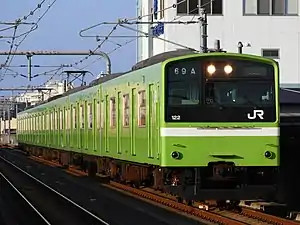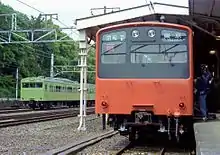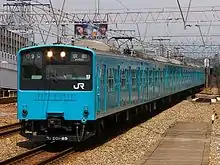201 series
The 201 series (201系, 201-kei) is a DC electric multiple unit (EMU) commuter train type introduced in 1979 by Japanese National Railways (JNR), and currently operated by West Japan Railway Company (JR-West), and formerly also operated by East Japan Railway Company (JR East).
| 201 Series | |
|---|---|
 A 201 series train arriving at Kizuri-Kamikata Station in 2019 | |
| In service | 1979–present |
| Manufacturer | Hitachi, Kawasaki Heavy Industries, Kinki Sharyo, Nippon Sharyo, Tokyu Car Corporation |
| Replaced | 101 series 103 series |
| Constructed | 1979 (201-900 series prototype) 1981–1985 |
| Entered service | 20 August 1979 |
| Refurbished | 2003–2007 (JR-West) |
| Number built | 1,018 vehicles |
| Number in service | 132 vehicles |
| Number preserved | 1 vehicle |
| Number scrapped | 885 vehicles |
| Successor | E231 series, E233 series, 321 series, 323 series |
| Operator(s) | JNR (1979–1987) JR East (1987–2011) JR-West (1987–present, scheduled to end operation in 2023) |
| Depot(s) | Morinomiya Nara |
| Line(s) served | Yamatoji Line, Sakurai Line, Wakayama Line, Osaka Higashi Line |
| Specifications | |
| Car body construction | Steel |
| Car length | 20 m |
| Maximum speed | 100 km/h (60 mph) (service) 110 km/h (70 mph) (design speed) |
| Traction system | Thyristor chopper |
| Traction motors | MT60 (150Kw) |
| Acceleration | 2.5 km/h/s |
| Deceleration | 3.5 km/h/s |
| Electric system(s) | 1,500 V DC overhead |
| Current collection method | PS21 diamond-shaped pantograph |
| Braking system(s) | Regenerative brake, electro-pneumatic brake |
| Safety system(s) | ATS-S, ATS-SN, ATS-SW, ATS-B, ATS-P |
| Track gauge | 1,067 mm (3 ft 6 in) |
It was the first JNR train to use electronic chopper control.[1]

Operations
The 201 series stock has been used on a large number of lines.
JR-West
- Kansai Main Line (Yamatoji Line), Sakurai Line (Manyo Mahoroba Line), Wakayama Line (from 2006 to 2023)
- Osaka Higashi Line (from 2008 to 2023)
JR-West
- Tokaido Main Line, Sanyo Main Line (Biwako Line, JR Kyoto Line, JR Kobe Line) (Kusatsu - Kakogawa) (from 1983 to 2007)
- Kosei Line (from 1997 to 2007)
- Fukuchiyama Line (JR Takarazuka Line) (from 1997 to 2007)
- Osaka Loop Line (from 2005 to 7 June 2019)
- Sakurajima Line (JR Yumesaki Line) (from 2005 to 2019)
JR East
- Chūō Rapid Line (10-cars) (from 1979 to October 2010)[2]
- Chūō-Sōbu Line (10 cars) (from 1982 to 2001)
- Ōme Line (4 cars) (from 1999 to 2008)
- Itsukaichi Line (6 cars) (from 1999 to 2008)
- Hachikō Line (6+4 cars)(Hachiōji - Komagawa, until March 2008)
- Keiyō Line, Sotobō Line, Tōgane Line (10 cars) (from 2000 to 20 June 2011)[3]
- Musashino Line (6 cars) (from 3 March 1986 to november 1996)
 201 series on JR Kyoto Line service in August 2004
201 series on JR Kyoto Line service in August 2004 Osaka Loop Line 201 series refurbished train in May 2007
Osaka Loop Line 201 series refurbished train in May 2007 Yamatoji Line 201 series refurbished train in December 2007
Yamatoji Line 201 series refurbished train in December 2007 A Chuo/Ōme Line 201 series in October 2010
A Chuo/Ōme Line 201 series in October 2010 A Keiyo Line 201 series in February 2007
A Keiyo Line 201 series in February 2007 A Chūō-Sōbu Line 201 series in May 2001
A Chūō-Sōbu Line 201 series in May 2001
Shikisai train
A 4-car 201 series set (W1) was modified in 2001 by JR East to become the special Shikisai (四季彩) tourist train, entering service on the Ōme Line from 4 August 2001. This train featured panorama windows and transverse seating bays on one side of the train only. It was repainted into a new livery in June 2005.[4] The train was withdrawn from regular service at the end of June 2009, with a number of special finale runs scheduled for July.[5]
 Shikisai train in original livery in May 2004
Shikisai train in original livery in May 2004 Shikisai train in revised livery (and windows) in June 2007
Shikisai train in revised livery (and windows) in June 2007.jpg.webp) Interior view in November 2008
Interior view in November 2008
Preserved examples
- KuHa 201-1: preserved at Toyoda Depot
 KuHa 201-1 at Toyoda Depot in 2014
KuHa 201-1 at Toyoda Depot in 2014
References
- JR全車両ハンドブック2006 [JR Rolling Stock Handbook 2006]. Japan: Neko Publishing. 2006.
- "201系四半世紀の歩み". Japan Railfan Magazine. 45 (526). February 2005.
- JR East news release: "「さよなら中央線201系」キャンペーン<第2弾>を開催します" (25 February 2010). Retrieved 17 June 2010. (in Japanese)
- 京葉線の201系が定期運用を終える [Keiyō Line 201 series withdrawn from regular service]. Japan Railfan Magazine Online (in Japanese). Japan: Koyusha Co., Ltd. 21 June 2011. Retrieved 21 June 2011.
- JR電車編成表 2009夏 [JR EMU Formations - Summer 2009]. Japan: JRR. June 2009. ISBN 978-4-330-06909-8.
- Japan Railfan Magazine: "201系「四季彩」,青梅線定期運用を終了" (28 June 2009) Archived 30 June 2009 at the Wayback Machine. Retrieved on 28 June 2009. (in Japanese)
External links
| Wikimedia Commons has media related to 201 series. |
- "JR East 201 series". jreast.co.jp (in Japanese). Archived from the original on 15 January 2008. Retrieved 2008-01-21.
